|
April 1961 Popular Electronics
 Table
of Contents Table
of Contents
Wax nostalgic about and learn from the history of early electronics. See articles
from
Popular Electronics,
published October 1954 - April 1985. All copyrights are hereby acknowledged.
|
Have you heard of an electronic
musical instrument called a Theremin?
You can still buy from Moog today the same sort of
Theremin that was described in this
Carl & Jerry episode from a 1961 issue of Popular Electronics
magazine. Ever the early adopters of breaking technology, the teenagers exploit
the motion-sensitive feature of the Theremin in hopes of improving Carl's basketball
game. As usual the boys, in mock dialog, describe the Theremin's operational theory
for the benefit of readers not familiar with the musical instrument. They do not,
however, mention that the device is named after its Russian inventor,
Léon Theremin,
who patented the device in 1928. Read on to discover how a Theremin strapped to
Jerry's back was used to help Carl be a better free-thrower.
Carl & Jerry: Therry and the Pirates
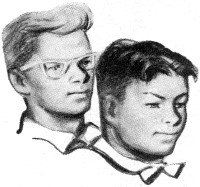 By John T. Frye By John T. Frye
The huge high school gymnasium was dark and empty except for a spot-lighted basketball
goal down at one end of the floor and the shadowy figures of Carl and Jerry standing
beneath it. Carl was clad in his basketball uniform, but Jerry was wearing his usual
shapeless sweater and fashionably beat-up cords.
"I must have been out of my cotton-picking mind when I let you talk me into this
caper," Carl muttered while Jerry busied himself strapping a strange apparatus to
the broad back of his athletic chum. Belts around Carl's waist and chest held a
broomstick erect at his back so that the handle rose a few inches above his left
shoulder. Fastened at the top of the handle was a small aluminum chassis box with
dials, jacks, and switches on the back of it. Two quarter-inch aluminum tubes stuck
out the top of the box and went straight up, side by side and some six inches apart,
for a distance of a couple of feet.
"You want to improve your free-throwing, don't you?" Jerry demanded, as he threw
a switch on the little box. "Let's go over and sit down for a few minutes while
those oscillators stabilize."
"Yeah," Carl agreed, seating himself gingerly on the substitutes' bench, "but
I keep wondering if the Globetrotters started this way. Tell me again about this
thing riding my back."
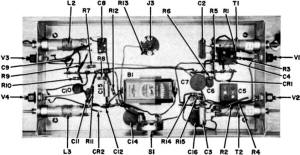
Robert Moog's
Theremin that appeared in the January 1961 edition of Electronics
World.
"The little box contains the tone-generating sections of two separate
theremins," Jerry
replied, stretching out on his back and closing his eyes. "You know what a theremin
is and how it works, don't you ?"
"I know it's a musical instrument played by just waving the hands near a couple
of rods or plates. I think the motion of one hand controls the pitch of the tone
produced, and the motion of the other controls the volume. But I've only a very
foggy notion of how this is done."
"All right, let's think about the tone-generating portion first," Jerry suggested.
"It consists of a couple of oscillators operating around 150 kc. In this case the
oscillators are transistorized, because I copied them from a construction article
on a transistorized theremin that appeared in theJanuary 1961, issue of
Electronics World.
"The outputs of both oscillators are fed to a diode mixer that combines them
and produces an audio signal with a pitch equal to any difference in frequency between
the oscillators. One oscillator stays on the same frequency all the time. The other
has a sense antenna, usually a metal rod or tube, connected to its frequency-determining
circuit so that any capacity between this antenna and an object brought near it,
like a human hand, adds capacitance to the circuit and lowers the frequency of the
oscillator. The amount of capacitance depends on how near the hand is held to the
sense antenna - the closer the hand, the greater the capacitance.
"This, of course, changes the difference-frequency between the two oscillators
and so changes the pitch of the tone produced by the instrument. Since the actual
amount of hand-capacity is quite small, a circuit is used with the sense antenna
that effectively amplifies this hand-capacity. When the variable oscillator is tuned
to zero-beat the fixed oscillator with the hand away from the sense antenna, moving
the hand toward the antenna from about a foot and a half away will cause the audio
tone to go up several octaves from a very low pitch."
"I'm with you so far," said Carl, "but how does moving the other hand change
the volume?"
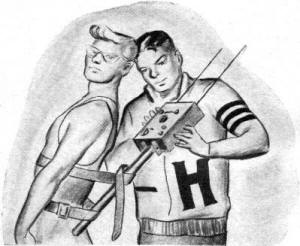 "The volume control circuit uses another
low-frequency oscillator," continued Jerry. "A resistor connects the tank circuit
of this oscillator to a series-tuned circuit resonated near the oscillator frequency.
The resistor and the tuned circuit form an r.f. voltage divider across the oscillator
tank. A diode rectifies any r.f. voltage appearing at the junction point, and the
d.c. thus produced is applied as bias to a transistor amplifying the signal delivered
by the tone-generating portion. When do you think the least r.f. voltage will appear
at the junction of the resistor and tuned circuit ?" "The volume control circuit uses another
low-frequency oscillator," continued Jerry. "A resistor connects the tank circuit
of this oscillator to a series-tuned circuit resonated near the oscillator frequency.
The resistor and the tuned circuit form an r.f. voltage divider across the oscillator
tank. A diode rectifies any r.f. voltage appearing at the junction point, and the
d.c. thus produced is applied as bias to a transistor amplifying the signal delivered
by the tone-generating portion. When do you think the least r.f. voltage will appear
at the junction of the resistor and tuned circuit ?"
"When the circuit is tuned to the resonant frequency of the oscillator," Carl
answered promptly. "A series-tuned circuit has a very low impedance at its resonant
frequency, but this impedance goes up rapidly as the circuit is detuned either way."
"Exactly right. The tuned circuit is adjusted to resonance with the left hand
away from a metal plate that is connected to the tuned circuit. Under these conditions,
practically no bias voltage is produced, and the amplifier works at full output.
"As the hand is brought nearer the plate," Jerry went on, "hand capacity causes
the resonant frequency of this tuned circuit to go lower than the oscillator frequency.
The impedance of the series-tuned circuit rises, as does the amount of bias voltage
developed. This voltage reduces the output of the amplifier. In fact, when the hand
is about an inch away from the volume control plate, the amplifier is completely
cut off.
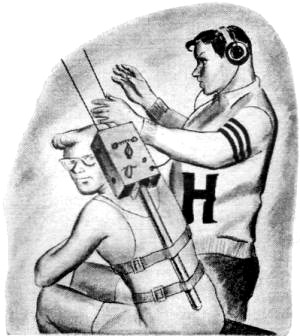 "Now this volume-controlling action is interesting,
but it doesn't concern 'Therry' here. He just has two tone-generating systems, each
with its own antenna, and without any volume control portions. Let's see if he's
operating." "Now this volume-controlling action is interesting,
but it doesn't concern 'Therry' here. He just has two tone-generating systems, each
with its own antenna, and without any volume control portions. Let's see if he's
operating."
Jerry plugged a pair of stereophonic earphones into a jack at the rear of the
aluminum box and moved his hand experimentally around the two antennas. Satisfied,
he handed the earphones to Carl.
"I spent a lot of time making those two tone generators perform exactly alike,"
Jerry said. "Notice that when I move my hand away from the middle of the two antennas
along a line that keeps it equally distant from both, the tones heard in both ears
stay exactly in step for all positions of the hand. But when I deviate from this
line, even a little bit, the tones are different. The tone coming from the antenna
nearest the hand is higher in frequency. Now let's see if Therry really works."
They moved to the foul circle, and Carl started pushing up shots at the basket.
Jerry, wearing the earphones, kept twisting the broomhandle until the antennas were
in a position where the sound he heard when Carl made a basket was a single-tone
eeeoooop, This was produced by the rapid movement of Carl's left hand going up at
an angle from the bottom center of the two antennas and keeping equally distant
from them until the ball left his fingers.
At this point Jerry placed the earphones on Carl's head, and connected a tape
recorder to the output of one of the theremin units. Then he fed balls back to Carl
while the latter continued pushing them up at the rim of the basket. Maybe it was
chance, maybe it was that listening to the sound somehow unlocked the foul-shooting
block that Carl had recently developed; but his percentage of goals went up sharply
soon after he put on the earphones. Finally he hit eleven in a row, and then closed
his eyes tightly and lifted a twelfth straight through the hoop guided only by the
sound in the earphones.
"I'll quit on that one," Carl said with a pleased grin as he began to unstrap
the device from his back; "but I believe old Therry here helps. Anyway, let's all
three. of us do this some more every night until the big game Friday."
Jerry made an endless loop of tape carrying the theremin sound of a perfect shot,
and each evening before Carl started practicing, Jerry would let this run a few
times over the gymnasium sound system, to "prime the pump" as he put it. Carl's
percentage of good shots not only continued at the same high level but actually
improved.
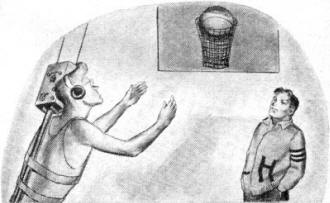 The theory was that Jerry permitted another sense to be brought
to bear on the acquiring of a skill. Carl's eyes could follow critically the arc
of the ball; from his muscles and joints came a kinesthetic sensation of the wrong
and right movements; and now his ears could hear the difference between hits and
misses. The theory was that Jerry permitted another sense to be brought
to bear on the acquiring of a skill. Carl's eyes could follow critically the arc
of the ball; from his muscles and joints came a kinesthetic sensation of the wrong
and right movements; and now his ears could hear the difference between hits and
misses.
Friday night the gym was filled to the rafters for the game with the Pottsville
Pirates. The Pirates and the hometown Huckleberries had been traditional enemies
for many years, and as far as either town was concerned this was the most important
game of the season.
Jerry, as usual, was working the sound system; and he watched anxiously to see
if Carl would be in the starting line-up. He breathed a sigh of relief as he saw
his chum preparing to jump center against a rangy Pirate at least two inches taller,
but he couldn't help thinking Carl looked a little naked without Therry strapped
to his back.
The game was fought bitterly right from the start. At the half, the Huckleberries
led by three points; but in spite of everything they could do, the Pirates relentlessly
overhauled them and forged ahead by two full field goals at the end of the third
quarter. When the Huckleberries came running out on the floor at the beginning of
the last quarter, Jerry could see that Carl's jaw was set in a grim line.
Carl and the other Huckleberries played furiously, but the Pirates fought back
just as hard. The battle raged up and down the floor as the seconds ticked away
on the time clock. The score was 50 to 49 in favor of the Pirates. Finally, when
the timekeeper was holding his pistol aloft with his eyes glued to the clock, Carl
stole the ball from under the Pirates' goal and came charging down the floor. From
far out, he leaped into the air and fired a desperate long shot at the basket as
clawing Pirate hands tore at his wrists and the final gun rang in his ears.
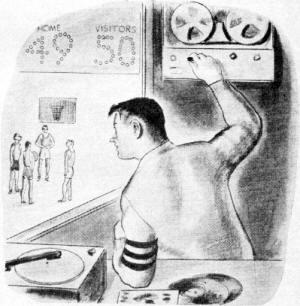 The ball hit the backboard, fell down to
the rim of the basket, rolled tantalizingly around it, then fell outside. A deep
groan arose from the Huckleberry rooting section. But the referee was blasting away
on his whistle and holding up two fingers while he waved Carl to the foul circle. The ball hit the backboard, fell down to
the rim of the basket, rolled tantalizingly around it, then fell outside. A deep
groan arose from the Huckleberry rooting section. But the referee was blasting away
on his whistle and holding up two fingers while he waved Carl to the foul circle.
It was very quiet in the gymnasium as Carl deliberately bounced the ball a couple
of times before trying his first free throw. Jerry could see that the muscles in
his shoulders were bunched with tension. When Carl attempted the shot, it did not
even come close; and a murmur of disappointment ran over the crowd.
Up in the sound booth, Jerry made a quick decision. He switched the tape recorder
into the P.A. system and started the loop of tape on it moving past the tape heads.
"Eeeeoooop, eeeeoooop, eeeeoooop!" was the sound that suddenly burst from the speakers,
and hundreds of eyes turned to shoot indignant looks at Jerry. But the latter, watching
his friend down on the floor, saw the tenseness go out of Carl.
Confidently Carl pushed the ball up in one easy, effortless motion. The ball
swished through the hoop without touching it!
The ensuing overtime to break the tie was really anticlimactic. Nothing could
stop the exuberant Huckleberries now, and the final score was 58 to 52 in their
favor.
The fans swarmed around Carl and literally carried him off the floor. But as
they surged past the sound booth, Carl looked at Jerry and threw up a long arm to
make an appreciative, triumphant gesture with a circled thumb and forefinger. Therry
was being given the credit for winning the game!
|
Carl Anderson and Jerry Bishop were two teenage boys whose
love of electronics, Ham radio, and all things technical afforded them ample opportunities
to satisfy their own curiosities, assist law enforcement and neighbors with solving
problems, and impressing – and sometimes toying with - friends based on their proclivity
for serious undertakings as well as fun.
- See Full List -
 Carl & Jerry, by John T. Frye Carl & Jerry, by John T. Frye
Carl and Jerry Frye were fictional characters in a series of short stories that
were published in Popular Electronics magazine from the late 1950s to the early
1970s. The stories were written by John T. Frye, who used the pseudonym "John T.
Carroll," and they followed the adventures of two teenage boys, Carl Anderson and
Jerry Bishop, who were interested in electronics and amateur radio.
In each story, Carl and Jerry would encounter a problem or challenge related
to electronics, and they would use their knowledge and ingenuity to solve it. The
stories were notable for their accurate descriptions of electronic circuits and
devices, and they were popular with both amateur radio enthusiasts and young people
interested in science and technology.
The Carl and Jerry stories were also notable for their emphasis on safety and
responsible behavior when working with electronics. Each story included a cautionary
note reminding readers to follow proper procedures and safety guidelines when handling
electronic equipment.
Although the Carl and Jerry stories were fictional, they were based on the experiences
of the author and his own sons, who were also interested in electronics and amateur
radio. The stories continue to be popular among amateur radio enthusiasts and electronics
hobbyists, and they are considered an important part of the history of electronics
and technology education.
|
-
Lie Detector Tells All - November 1955
-
The
Educated Nursing - April 1964
- Going Up
- March 1955
-
Electrical
Shock - September 1955
- A Low Blow
- March 1961
- The Black
Beast - May 1960
- Vox
Electronik, September 1958
- Pi in
the Sky and Big Twist, February 1964
-
The
Bell Bull Session, December 1961
- Cow-Cow
Boogie, August 1958
- TV Picture,
June 1955
- Electronic
Eraser, August 1962
- Electronic
Trap, March 1956
- Geniuses
at Work, June 1956
- Eeeeelectricity!,
November 1956
- Anchors
Aweigh, July 1956
- Bosco
Has His Day, August 1956
- The Hand
of Selene, November 1960
- Feedback,
May 1956
- Abetting
or Not?, October 1956
-
Electronic Beach Buggy, September 1956
-
Extra Sensory Perception, December 1956
- Trapped
in a Chimney, January 1956
- Command
Performance, November 1958
- Treachery
of Judas, July 1961
- The Sucker,
May 1963
-
Stereotaped
New Year, January 1963
- The
Snow Machine, December 1960
-
Extracurricular Education, July 1963
-
Slow Motion for Quick Action, April 1963
- Sonar
Sleuthing, August 1963
- TV Antennas,
August 1955
- Succoring
a Soroban, March 1963
- "All's
Fair --", September 1963
-
Operation
Worm Warming, May 1961
|
-
The Electronic Bloodhound - November 1964
-
Great Bank Robbery or "Heroes All" - October 1955
-
Operation Startled Starling - January 1955
- A Light
Subject - November 1954
- Dog
Teaches Boy - February 1959
- Too Lucky
- August 1961
- Joking
and Jeopardy - December 1963
-
Santa's Little Helpers - December 1955
- Two
Tough Customers - June 1960
-
Transistor
Pocket Radio, TV Receivers
and
Yagi Antennas, May 1955
- Tunnel
Stomping, March 1962
- The Blubber
Banisher, July 1959
- The Sparkling
Light, May 1962
-
Pure
Research Rewarded, June 1962
- A Hot Idea, March
1960
- The Hot Dog
Case, December 1954
- A
New Company is Launched, October 1956
- Under
the Mistletoe, December 1958
- Electronic
Eraser, August 1962
- "BBI", May 1959
-
Ultrasonic
Sound Waves, July 1955
- The River
Sniffer, July 1962
- Ham Radio,
April 1955
- El
Torero Electronico, April 1960
- Wired
Wireless, January 1962
-
Electronic Shadow, September 1957
- Elementary
Induction, June 1963
- He Went
That-a-Way, March1959
- Electronic
Detective, February 1958
- Aiding
an Instinct, December 1962
- Two Detectors,
February 1955
-
Tussle
with a Tachometer, July 1960
- Therry
and the Pirates, April 1961
-
The Crazy Clock Caper, October 1960
|
 Carl & Jerry: Their Complete Adventures is
now available. "From 1954 through 1964, Popular Electronics published 119 adventures
of Carl Anderson and Jerry Bishop, two teen boys with a passion for electronics
and a knack for getting into and out of trouble with haywire lash-ups built in Jerry's
basement. Better still, the boys explained how it all worked, and in doing so, launched
countless young people into careers in science and technology. Now, for the first
time ever, the full run of Carl and Jerry yarns by John T. Frye are available again,
in five authorized anthologies that include the full text and all illustrations." Carl & Jerry: Their Complete Adventures is
now available. "From 1954 through 1964, Popular Electronics published 119 adventures
of Carl Anderson and Jerry Bishop, two teen boys with a passion for electronics
and a knack for getting into and out of trouble with haywire lash-ups built in Jerry's
basement. Better still, the boys explained how it all worked, and in doing so, launched
countless young people into careers in science and technology. Now, for the first
time ever, the full run of Carl and Jerry yarns by John T. Frye are available again,
in five authorized anthologies that include the full text and all illustrations." |
Posted November 4, 2021
(updated from original post on 8/27/2014)
|




























 By John T. Frye
By John T. Frye




 Carl & Jerry, by John T. Frye
Carl & Jerry, by John T. Frye
